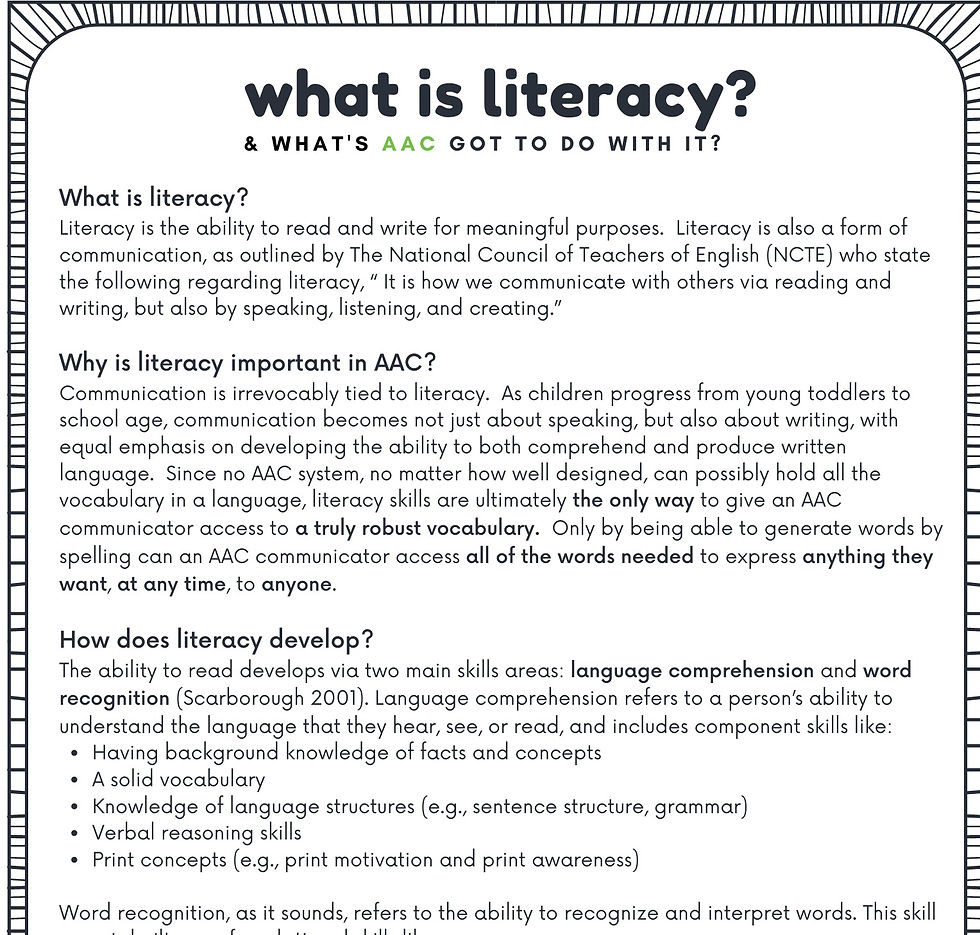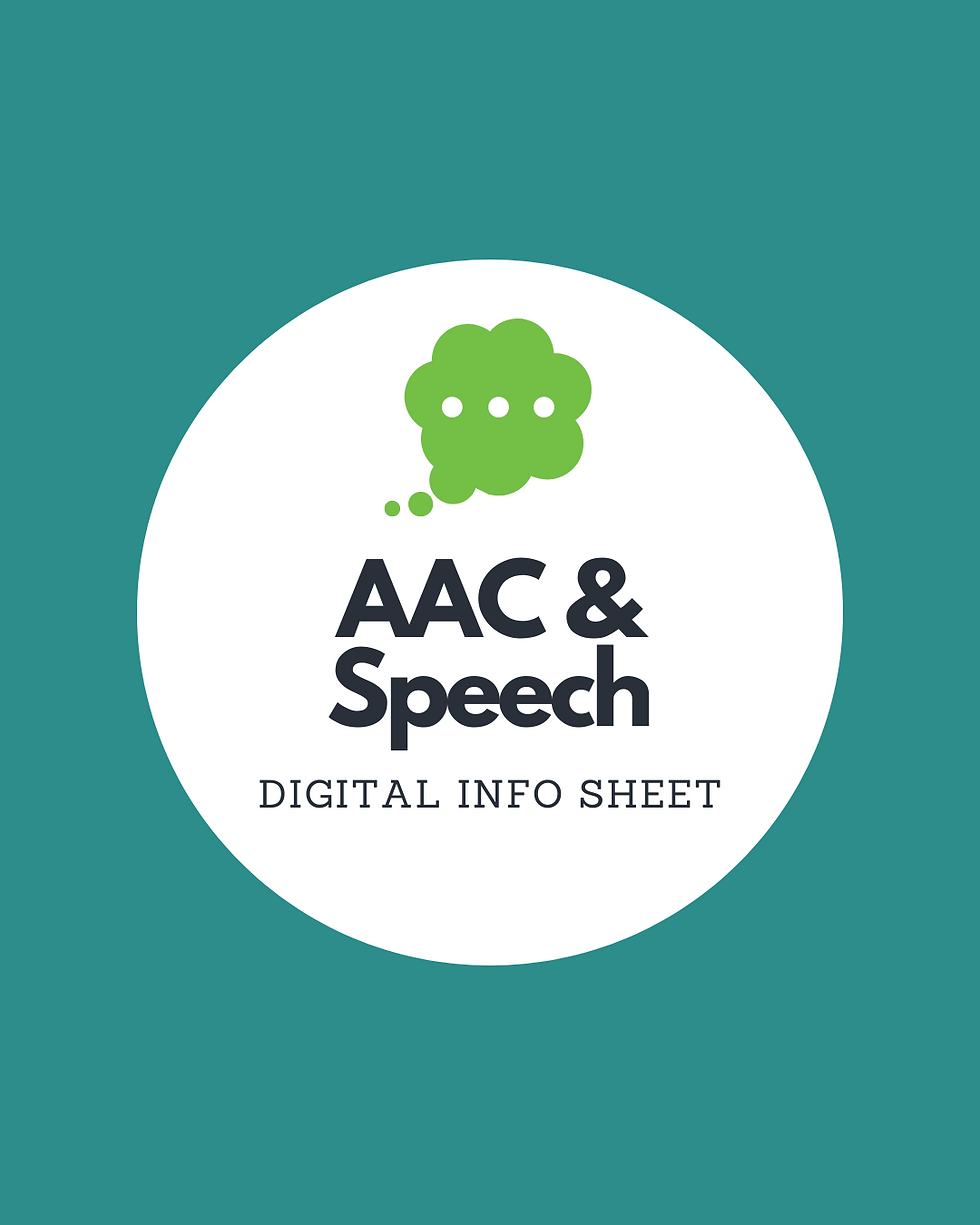
What is AAC?
Augmentative and alternative communication or AAC is a big term used to describe the tools and strategies a child might use to support successful communication when speech is not present or is limited in some way. AAC is a system of tools and strategies, not just one. We all use many forms of AAC in our own daily communication when the situation calls for such or to enhance our spoken communication. When you write a message, use a gesture, make a facial expression, or nod your head, you are using AAC. Children who struggle to speak can be taught to use a variety of AAC tools and strategies to communicate effectively.
When a child is struggling to communicate because speech has not developed as it should at his age or speech is limited in some way, AAC can help. Children who may benefit from AAC demonstrate a range of communication skills and challenges as they enter their AAC journeys and begin to find their way to effective and independent communication. Learning to use AAC to effectively communicate is a journey, not a destination. Children who use AAC are joined on this journey by supportive partners who are engaged in the process and dedicated to learning alongside the child. These AAC Guides include family members, therapists, teachers, and friends. A child's AAC journey involves lots of practice using new skills and strengthening existing skills. AAC tools and strategies are adjusted along the way as the child's needs and skills change. With appropriate and supportive therapy and education programs that presume competence, model language, and foster literacy skills, children who use AAC can achieve their full potentials and lead productive and fulfilling lives as Conquerors through powerful, independent communication.
AAC is a system of communication, not just one tool. Children who use AAC may use speech, gesture, sign language, and various forms of picture communication in their AAC systems. Some AAC tools don't involve any technology at all, such as the use of gestures or sign language. Other AAC tools may be printed, such as picture communication books and boards. There are also many AAC tools that use new technology, such as apps that can be installed on tablets and computers and produce voice. It isn't uncommon for a child learning to use AC to use a combination of all of these tools depending on who she is communicating with and in what environment.
Tools
Unaided AAC
Using gestures, facial expressions, hand signs or signed language helps children with no speech or limited speech convey their basic wants, needs, and ideas without the need for extra technology. These tools are with a child all of the time, making each powerful for quick communication. Some children have physical challenges with their hands and fingers that limit their ability to produce hand signs or signed language. The use of gestures can also be less clear with communication partners who don't know a child as well. Using these "unaided" forms of communication is often not enough to help children develop powerful language and therefore, other AAC tools may be used in partnership with these quick communication tools.
Aided AAC
Communication Books & Boards
A printed communication book or board allows a child to communicate by giving a picture to a partner or by pointing with his finger, gaze, or with another form of supported pointing, such as using a wand or a whole hand. Sometimes children use printed books and boards to communicate with the help of a partner, through a technique called "partner assisted scanning". This is helpful when a child has physical challenges that make pointing to a picture difficult. Printed books and boards can be customized to a child's needs and can have a range of words and phrases to support effective communication. Many can be purchased or downloaded from various websites and an AAC guide can assist a child and family in creating and learning to use them. These aided" and "light tech" tools are often readily available and cost effective.
Communication Apps & Devices
AAC tools that are used on iPads, tablets, computers, and other computerized devices offer children access to a wide range of pictures to communicate along with speech output. AAC apps can be simple or robust, supporting communication needs that range from basic wants and needs to full conversations. Many apps and devices also come with tools for spelling a communication message and features to help creating communication with technology go more quickly. Children who use AAC devices to communicate can do so by touching the screen with a finger, a wand, or by using external "switches" if there are physical challenges that make pointing and touch difficult or impossible. Many apps and devices also offer a way for children to use the words on the screen by pointing with their eyes. There are many apps and devices available so a qualified AAC Guide is important to help families identify the tool that is the best fit for a child's needs and abilities.
Strategies
AAC isn't just tools, it also includes strategies used by both communicators and their partners to support successful communication. Children who struggle to communicate must develop strategies to help them repair communication when others do not understand. Learning these "communication repair" strategies is a big part of the AAC journey and partners play a big role in this teaching. Partners who support and communicate with children who use AAC must learn strategies to provide intensive AAC immersion, to pace and appropriately present their own communication, and even to assist some AAC users in accessing their communication system, such as through partner assisted scanning. See other resources on AACcessible to learn more about AAC strategies for communicators and partners.
So which AAC tools & strategies should I choose?
The best way to find the best AAC fit for your child and family is to meet with a qualified AAC professional for a comprehensive evaluation that includes what is called “feature matching”. In the feature matching process, a professional such as speech therapist, special educator, or assistive technology expert will help you compare the skills and needs of the communicator with the features of AAC tools available to find a tool that meets immediate needs and offers room for growth. This professional will also help to identify intervention strategies that may be most beneficial in helping your communicator and family learn to use AAC over time. You can learn more about AAC assessment, features, and the feature matching process on this AAC Path Page.
























